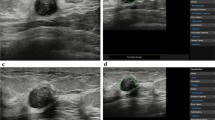Abstract
Purpose
The purpose of this study was to evaluate the usefulness of a computer-aided diagnosis (CAD) scheme for improving the performance of clinicians to diagnose non-mass lesions appearing as hypoechoic areas on breast ultrasonographic images.
Methods
The database included 97 ultrasonographic images with hypoechoic areas: 48 benign cases [benign lesion with benign mammary tissue or fibrocystic disease (n = 20), fibroadenoma (n = 11), and intraductal papilloma (n = 17)] and 49 malignant cases [ductal carcinoma in situ (n = 17) and invasive ductal carcinoma (n = 32)]. Seven clinicians, three expert breast surgeons, and four general surgeons participated in the observer study. They were asked their confidence level concerning the possibility of malignancy in all 97 cases with and without the use of the CAD scheme. Receiver operating characteristic (ROC) analysis was performed to evaluate the usefulness of the CAD scheme.
Results
The areas under the ROC curve (AUC) improved for all observers when they used the CAD scheme and increased from 0.649 to 0.783 (P = 0.0167). Notably, the AUC for the general surgeon group increased from 0.625 to 0.793 (P = 0.045).
Conclusions
This study showed that the performance of clinicians to diagnose non-mass lesions appearing as hypoechoic areas on breast ultrasonographic images was improved by the use of a CAD scheme.







Similar content being viewed by others
References
Crystal P, Strano SD, Shcharynski S, et al. Using sonography to screen women with mammographically dense breasts. AJR. 2003;181:177–82.
Ohuchi N, Suzuki A, Sobue T, et al. Sensitivity and specificity of mammography and adjunctive ultrasonography to screen for breast cancer in the Japan Strategic Anti-cancer Randomized Trial (J-START): a randomized controlled trial. Lancet. 2015; doi:10.1016/S0140-6736(15)00774-6.
Tohno E, Ueno E, Watanabe H. Ultrasound screening of breast cancer. Breast Cancer. 2009;16:18–22.
Doi K. Computer-aided diagnosis in medical imaging: historical review, current status and future potential. Comput Med Imaging Graph. 2007;31:198–211.
Nakayama R, Namba K, Watanabe R, et al. Potential usefulness of presentation of histological classifications with computer-aided diagnosis (CAD) scheme in differential diagnosis of clustered microcalcifications on mammograms. Breast Imaging: 12th International Workshop, IWDM 2014, Gifu City, Japan, June 29–July 2, 2014;8539:115–20.
Ying W, Hong W, Yanhui G, et al. Novel computer-aided diagnosis algorithms on ultrasound image: effects on solid breast masses discrimination. J Digit Imaging. 2010;23:581–91.
Kashikura Y, Nakayama R, Hizukuri A, et al. Improved differential diagnosis of breast masses on ultrasonographic images with a computer-aided diagnosis scheme for determining histological classifications. Acad Radiol. 2013;20:471–7.
Hizukuri A, Nakayama R, Kashikura Y, et al. Computer-aided diagnosis scheme for determining histological classification of breast masses using clinical features and texture features. In: Proceedings of the Forth International Workshop on Regional Innovation Studies—Biomedical Engineering; 2012. pp. 83–6.
Hizukuri A, Nakayama R, Kashikura Y, et al. Computerized determination scheme for histological classification of breast mass using objective features corresponding to clinicians’ subjective impressions on ultrasonographic images. J Digit Imaging. 2013;26:958–70.
Kobyashi T, Xu XW, Macmahon H, et al. Effect of a computer-aided diagnosis scheme on radiologists’ performance in detection of lung nodules on radiographs. Radiology. 1996;199:843–8.
Uozumi T, Nakamura K, Watanabe H, et al. ROC analysis of detection of metastatic pulmonary nodules on digital chest radiographs with temporal subtraction. Acad Radiol. 2001;8:871–8.
Dorfman DD, Berbaum KS, Metz CE. Receiver operating characteristic rating analysis. generalization to the population of readers and patients with the jackknife method. Invest Radiol. 1992;27:723–31.
Wang ZL, Li N, Li M, et al. Non-mass like lesions on breast ultrasound: classification and correlation with histology. Radiol Med. 2015;120:905–10.
Japan Association of Breast and Thyroid Sonography (JABTS). Guideline for breast ultrasound: management and diagnosis. 3rd ed. Nankodo, Tokyo; 2014. pp. 63–91.
American College of Radiology(ACR). Breast imaging reporting and data system, ultrasound. 5th ed. Reston, VA; 2013. pp. 1–153.
American College of Radiology (ACR). Breast imaging reporting and data system, magnetic resonance imaging. 4th ed. Reston, VA; 2003. pp. 1–114.
Sotome K, Yamamoto Y, Hirano A, et al. The role of contrast enhanced MRI in the diagnosis of non-mass image-forming lesions on breast ultrasonography. Breast Cancer. 2007;14:371–80.
Author information
Authors and Affiliations
Corresponding author
Ethics declarations
Conflict of interest
The authors declare that they have no conflicts of interest in association with the present study.
Ethical approval
This study was performed at Mie University Hospital, and was approved by the Ethical Review Board of Mie University Hospital. Informed consent was obtained from all patients for being included in the study.
About this article
Cite this article
Shibusawa, M., Nakayama, R., Okanami, Y. et al. The usefulness of a computer-aided diagnosis scheme for improving the performance of clinicians to diagnose non-mass lesions on breast ultrasonographic images. J Med Ultrasonics 43, 387–394 (2016). https://doi.org/10.1007/s10396-016-0718-9
Received:
Accepted:
Published:
Issue Date:
DOI: https://doi.org/10.1007/s10396-016-0718-9




